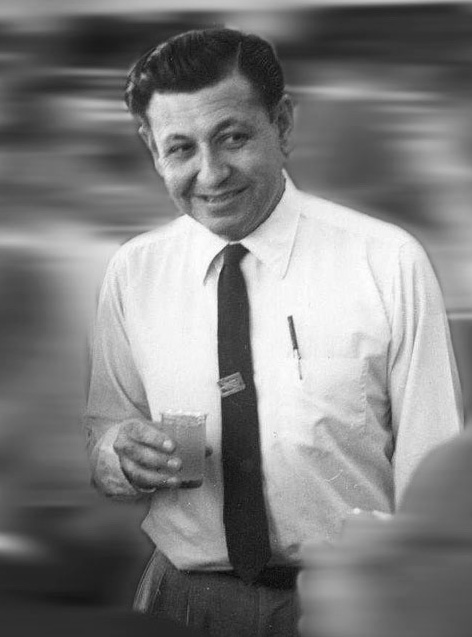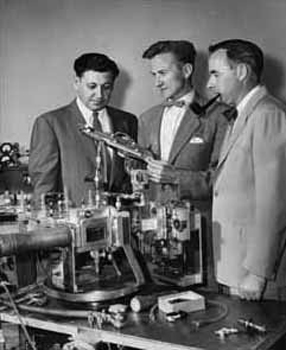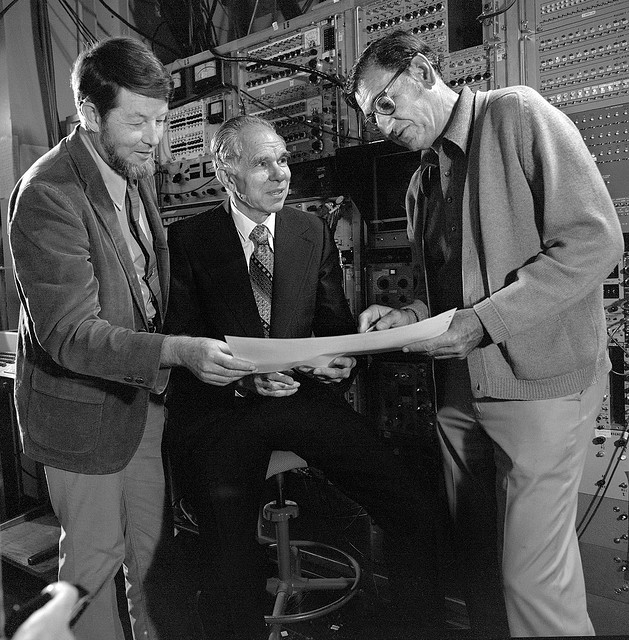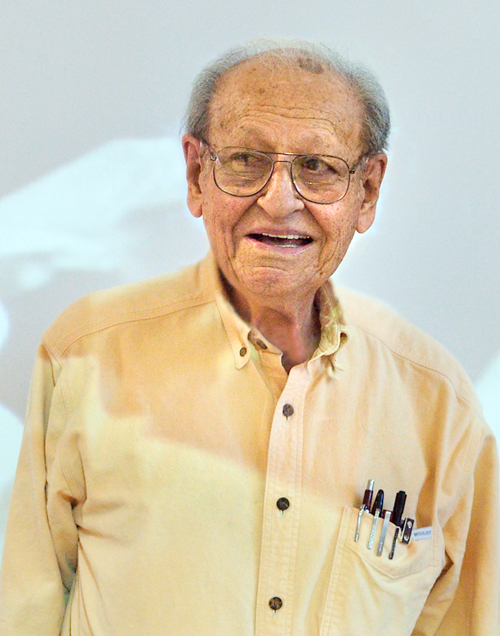The work and personality of Albert Ghiorso, who died December 26, 2010, at the age of 95, helped define Lawrence Berkeley National Laboratory during the middle decades of the 20th century.
Ghiorso’s colleague Walter Loveland, a professor of nuclear chemistry at Oregon State University, sums up the Ghiorso scientific legacy: “Al Ghiorso was one of the most important figures in 20th century nuclear science. His discovery/codiscovery of 12 chemical elements and his development of the techniques used to study these fundamental building blocks of nature give him a unique place in the history of science.”
The following reminiscences of Ghiorso’s unique and inimitable style have been contributed by some of his many coworkers and friends.
______________________________________________________________________

Albert Ghiorso in an undated photo (possibly 1955), well into his astonishingly productive element-hunting career.
“Al had a long, full, and wonderful life,” says James Symons, director of Berkeley Lab’s Nuclear Science Division (NSD). “He was a distinguished scientist, a true technical wizard, an artist, an ornithologist, a devoted husband and father, and, above all, a man of boundless curiosity and energy. He codiscovered 12 elements, built the HILAC [the Heavy Ion Linear Accelerator], and conceived the Bevalac [the Bevatron and HILAC coupled together]. He was a hands-on experimenter who was working on a novel approach to fusion in his early 90s!”
Symons adds, “Al’s formal education ended with a bachelor’s degree in Electrical Engineering, but he went on to make great discoveries in chemistry and physics. When we remember Al, we should think also of the sureness of Ernest Lawrence’s vision in creating an institution to bring together highly motivated and talented people, with very diverse backgrounds, to tackle important problems.”
Symons cites Ghiorso as an outstanding example of Lawrence’s foresight. “Al was originally hired at the Lab by Glenn Seaborg to work on the chemistry side of the Manhattan project. They were partners in the search for new chemical elements for half a century. When Glenn’s career took him away, first as UC Berkeley Chancellor, and then as Chairman of the Atomic Energy Commission under Kennedy and Johnson, it was Al who led the research activities back home for which they are both justly famous.”
The renowned nuclear chemist Darleane Hoffman was at the Los Alamos Scientific Laboratory when she first met Ghiorso “somewhat after the time of the discovery of the new elements 99 and 100 in the debris from the Mike thermonuclear test in the South Pacific, which was conducted in November 1952.” Mike was the world’s first test of a prototype hydrogen bomb, and everything about it was highly classified. But “Albert had gotten some air samples from the debris and, from analysis of the data and without knowledge of any of the classified details of the event, he was able to interpret it and also to verify the production of the previously unknown elements, which were later named einsteinium and fermium after Albert Einstein and Enrico Fermi. Together with coworkers from Los Alamos and Argonne National Laboratories, Albert was a coauthor of the subsequent unclassified paper announcing these discoveries.”
Among Ghiorso’s subsequent discoveries were elements 104 (rutherfordium) and 105 (originally named hahnium by its Berkeley Lab discoverers, now named dubnium). Kari and Pirkko Eskola, he a former professor of physics at Finland’s University of Jyväskylä and she a prominent science educator and publisher, recall that “We were members of Ghiorso’s research team at the HILAC during a very intense and productive period extending from 1968 to 1972 at the time of the discovery of elements 104 and 105. The four years showed us clearly what an extraordinarily ingenious, versatile, and imaginative scientist he was. With a surprisingly small research team, but with a wide net of connections, he led the way into the unknown territory of new elements.”

Ghiorso with Torbjorn Sikkeland and John Walton, members of the Seaborg group that discovered element 102 in May, 1958, using the HILAC.
The Eskolas credit these accomplishments to Ghiorso’s personal qualities: “Among other things he impressed us with his practical engineering skills and hands-on approach to any problem arising in the midst of an experiment. His mind was full of ideas on how to make changes in the ongoing series of measurements. It was his habit to be present in the experimental area until midnight during run times, and then often discuss with us his novel and uncommon ideas on how to solve actual and challenging problems in physics. Having been a coworker of Albert Ghiorso has been a great privilege and source of inspiration in later years.”
While not himself an element hunter, the distinguished nuclear scientist Art Poskanzer, codiscoverer of collective flow in nuclear matter, was the first scientific director of the Bevalac. “Al was a great experimentalist but did not get the recognition he deserved. He was a modest man who never sought recognition, and actually avoided it – he was just happy to do his work. In addition to his own pioneering research to produce many new elements, he had the ingenious idea to couple the HILAC and the Bevatron to make the Bevalac. This started the whole new field of relativistic nuclear collisions, which is very active today. He had a real impact on science at the Lab and worldwide.”
In 1978 Darleane Hoffman got to know Ghiorso better while on sabbatical at Berkeley Lab on a Guggenheim Fellowship. She participated in weekly group meetings of the Heavy Element Group with Ghiorso and Glenn Seaborg. After she moved to Berkeley from Los Alamos in 1984 as a professor of chemistry at the University of California at Berkeley, she herself eventually became head of the Heavy Element Group. She and Ghiorso worked closely together and became good friends. “Among his noteworthy attributes was his seemingly endless enthusiasm and optimism. Even during periods of reduced funding and minimal support, he had so many new ideas. No challenge was too great for him to address – and usually solve!”
Hoffman says it was primarily because of his wife, Wilma, that Ghiorso became interested in art and music. He became a patron of the arts and music and an artist himself. “His doodles were everywhere – in his notes, his notebooks – and they could easily be the basis for a publishable monograph,” she recalls. “A testament to his character, which I shall never forget, was his devotion to Wilma after she became ill. Albert would come to the lab early in the morning, maybe 5:00 a.m., and perform what for anyone else would be a full day’s work. And then, no matter what, he would leave by 11:00 a.m. to go home to fix lunch for Wilma, often returning later to work some more. I have never known anyone so faithful and devoted in my entire life.”
Says Hoffman, “As a long-time friend, colleague, collaborator in scientific projects, and someone who had discussions with Albert Ghiorso on topics ranging from science to politics to religion to health concerns, it seems nearly impossible for me to believe that Albert has left us and that he will no longer call me up to discuss his latest new idea for producing superheavy elements or some new instrument that we should be developing to enable us to take the next step forward. Albert always said that he wanted to live to be 112 to confirm discovery of that element, which we had tried unsuccessfully to produce earlier…. One of my biggest regrets is that we were not able to discover element 112 [now copernicium] at Berkeley – and name it ghiorsium.”
Perhaps hedging his bets, element 112 wasn’t the only element whose atomic number Ghiorso strove to match with his age. Heino Nitsche, current head of the Heavy Element Nuclear and Radiochemistry Group in NSD and a professor of chemistry at UC Berkeley, recalls that “Al and Darleane were instrumental in proposing the name seaborgium for element 106 and getting it through the IUPAC [the International Union of Pure and Applied Chemistry] naming committee. This success was very satisfying to Seaborg, Al, and Darleane. What I vividly remember was Al’s statement after the naming of element 106: ‘My goal is now to live up to 106 years to match the element’s number.’”

In 1974, at the upgraded SuperHILAC accelerator, Ken Hulet, Glenn Seaborg, and Albert Ghiorso examine evidence for the production of element 106.
From 1972 to 1974, Jose and Carol Alonso were members of the team that discovered element 106. Says Jose Alonso, an innovative leader in accelerators and other fields of physics, and himself a former director of the Bevalac, “It was certainly a unique honor for us, as two young postdocs, to be able to work with Al Ghiorso and Glenn Seaborg, true giants and pioneers in the transuranic element field. It was Al’s creative genius in developing experimental apparatus capable of ‘milking’ individual atoms that led to his discovering more new elements than anybody else…. Being responsible for analyzing the data collected during the 106 experiment, I would often have the challenging task of deciphering odd data sequences on the tapes to see which knobs Al had tweaked overnight to gain a few extra milliseconds in the collection window.” He adds, “During this time of intense competition from the group led by Academician Flerov in Dubna, Al’s careful, reproducible and verifiable work was absolutely crucial in establishing credibility of the work at Berkeley.”
Says retired physicist and Livermore Lab administrator Carol Alonso, “Although Glenn Seaborg was the titular head of our group, Al Ghiorso ran it on a day-to-day basis. A self-taught man who lacked the advanced degrees and international polish of those around him, Al worked harder, and perhaps more defensively, than any of us. Though he craved international recognition, Al seldom traveled or gave formal talks; instead he worked, worked, worked. In doing so he gave us all the benefit of his ingenuity, and his joy in his work.”
Like many, Carol was struck by Ghiorso’s compassion. “Al was always very human and humane. He carefully shielded his family from his job; we never saw them. He had a soft spot for those who were fighting their own personal battle, perhaps like himself. When one of our group in later years was dying of AIDS, Al spent time with him every day, caring for him physically, mentally, and financially.”
Adds Jose, “Having no family, Al became his support, caregiver, and pillar of strength. Eventually Al also became the executor of his estate, and established a foundation in his name to give awards to deserving technical staff, who normally work in the shadow of their scientific colleagues.”
Carol says, “Every one of us, when we needed help, could count on Al, even into his old age.”
NSD director James Symons identifies the young co-discoverer whom the Alonsos recall. “We all know that Al was a force of nature in the lab, but not all may know of his compassion and generosity to others. When he learned that his long-time colleague and codiscoverer of element 106, Mike Nitschke, was terminally ill, Al’s response was immediate and utterly typical. He simply dropped everything he was doing to assess the situation, research Mike’s treatment options, and organize his care and his affairs during the last months of his life.”

In 2005 Berkeley Lab’s Nuclear Science Division sponsored an international symposium to celebrate Ghiorso’s 90th birthday. He was still working regularly at his office in the building that once housed the SuperHILAC.
Berkeley Lab Distinguished Scientist Emeritus and Director Emeritus Andrew Sessler, currently of the Lab’s Accelerator and Fusion Research Division, confirms and extends other recollections of Ghiorso: “That he was imaginative and creative in his work is without doubt. His long list of discoveries shows it very clearly. But Al was also innovative and wise in scientific matters far beyond his transuranium work…. Al’s good judgment also extended to people.”
Ghiorso was a vigorous supporter of Sessler’s candidacy to become Lab director. “I was interviewed to be director in the spring of 1973 and then went to Europe for the summer as the Regents considered other possible directors. The LBL staff had strong opinions on the various candidates. In those days before e-mails, when phone calls were expensive, Al wrote to me regularly and at great length and thus kept me informed of the various machinations going on.”
One of Sessler’s most difficult decisions – “perhaps the most wrenching thing I did during my term” – came when he appointed another scientist over Ghiorso to manage the SuperHILAC. “Al had built the machine. Nurtured the machine. Developed an ever-improved machine. It was his machine…. but he was big enough to see my side and able to go along with it. A wonderful ability! We remained good friends for the many decades since those days in the 70s.”
One postdoc who worked at the SuperHILAC in those years was the prolific researcher Robert Schmieder, who is working on Ghiorso’s biography. “Albert Ghiorso became a legend and a metaphor for inspired nuclear research. Every physicist and chemist knew the significance of his work – the discovery and naming of more than 10 percent of the periodic table of the elements. Along the way he created innovative technology, from particle detectors to ultrafast chemical separations to massive accelerators for extending the search to even heavier elements. Those fortunate enough to know him personally were in awe of his brilliance, his ability to get results when others discounted his chances, and his magical ability to inspire others to devote their careers to the quest. All this was done with a quiet, modest personality that belied his power and endeared him to his colleagues.”
“My 25 years of daily interaction with Albert Ghiorso changed my life,” says Matti Nurnia, a professor and senior researcher at the University of Jyväskylä, who joined Ghiorso’s team in 1966 and two years later brought his students Kari and Pirkko Eskola aboard. Nurnia’s summary of Ghiorso’s scientific achievements concludes this selection of remembrances from a few of the numerous people whose lives were likewise changed:
“His lightning-fast mind, combined with his absolute fairness and his grasp of all aspects of our research, enabled him to lead our way in the synthesis and study of new elements. His leadership, from accelerator design and construction to production of exotic target materials to new concepts of detectors and persistence in looking for individual events, was the unique force that enabled Berkeley to dominate new-element research for twenty years. He and his colleague, the late Glenn Seaborg, did more that anyone else to establish the laws and phenomena that govern the landscape of the heaviest elements – a landscape that is one of the cornerstones of our view of the universe.”
Additional information
More about Albert Ghiorso.
Ghiorso’s colleagues and coworkers, including those quoted here and many others, attended a 2005 symposium in celebration of Ghiorso’s 90th birthday.
Read The Transuranium People, The Inside Story, by Darleane Hoffman, Albert Ghiorso, and Glenn Seaborg, available online. Ghiorso recalls his life in the second section of the preface.